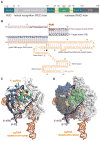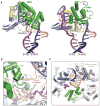Structures of a CRISPR-Cas9 R-loop complex primed for DNA cleavage
- PMID: 26841432
- PMCID: PMC5111852
- DOI: 10.1126/science.aad8282
Structures of a CRISPR-Cas9 R-loop complex primed for DNA cleavage
Abstract
Bacterial adaptive immunity and genome engineering involving the CRISPR (clustered regularly interspaced short palindromic repeats)-associated (Cas) protein Cas9 begin with RNA-guided DNA unwinding to form an RNA-DNA hybrid and a displaced DNA strand inside the protein. The role of this R-loop structure in positioning each DNA strand for cleavage by the two Cas9 nuclease domains is unknown. We determine molecular structures of the catalytically active Streptococcus pyogenes Cas9 R-loop that show the displaced DNA strand located near the RuvC nuclease domain active site. These protein-DNA interactions, in turn, position the HNH nuclease domain adjacent to the target DNA strand cleavage site in a conformation essential for concerted DNA cutting. Cas9 bends the DNA helix by 30°, providing the structural distortion needed for R-loop formation.
Copyright © 2016, American Association for the Advancement of Science.
Figures




Comment in
-
Structural biology. Cas9, poised for DNA cleavage.Science. 2016 Feb 19;351(6275):811-2. doi: 10.1126/science.aaf2089. Science. 2016. PMID: 26912877 No abstract available.
References
Publication types
MeSH terms
Substances
Associated data
- Actions
Grants and funding
LinkOut - more resources
Full Text Sources
Other Literature Sources

